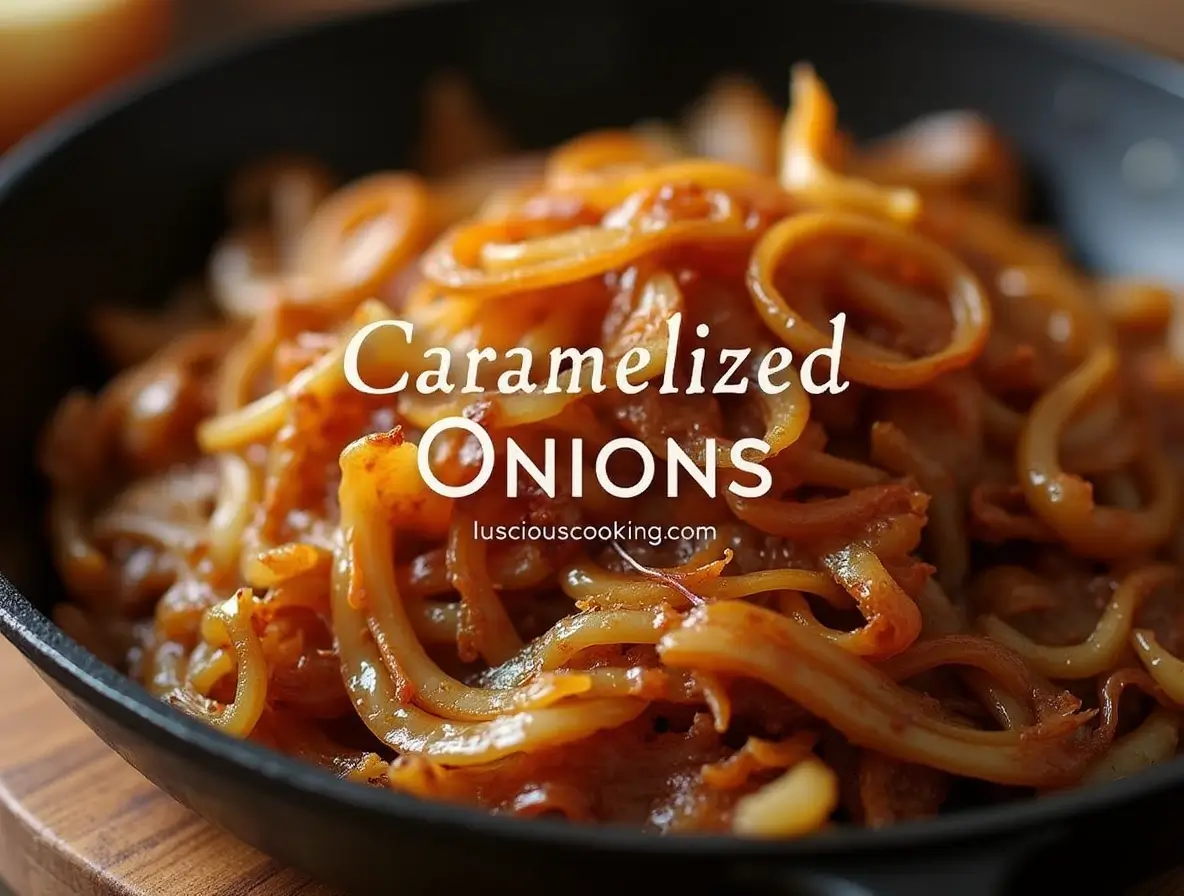Are you tired of ending up with burnt, bitter onions when trying to caramelize them? You’re not alone. Many home cooks struggle to achieve that perfect golden-brown color and rich, sweet flavor without turning their kitchen into a smoke-filled disaster zone. But what if I told you there’s a foolproof way to create restaurant-quality caramelized onions every single time?
In this comprehensive guide, we’ll walk you through the exact process that transforms ordinary onions into culinary gold. Whether you’re a beginner cook or a seasoned home chef, these five straightforward steps will help you master the art of caramelization while avoiding common pitfalls.
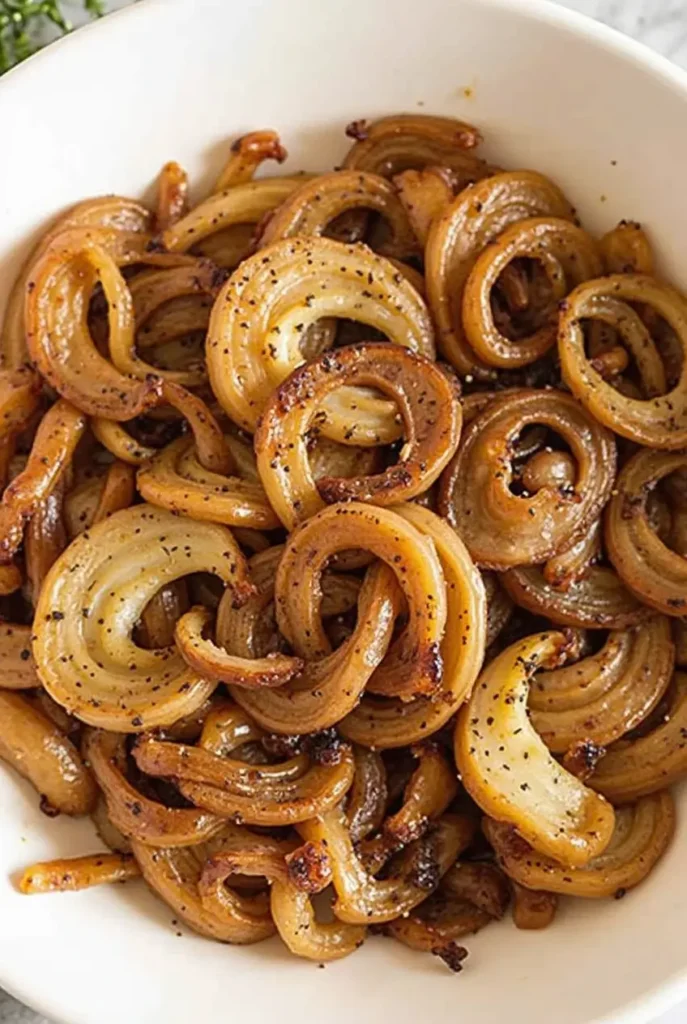
Let’s dive into the wonderful world of caramelized onions and Discover how this simple technique can transform your everyday dishes into extraordinary culinary creations.
Why This Caramelized Onion Technique Works
Caramelizing onions is more than just a Cooking technique – it’s a transformation that brings out the natural sweetness and depth of flavor hidden within these humble vegetables. Let’s explore why this method stands out among other onion preparations:
Flavor Profile
- Natural Sweetness: The slow-cooking process breaks down complex sugars, creating a rich, candy-like sweetness.
- Umami Boost: As onions caramelize, they develop deep savory notes that enhance any dish.
- Versatility: These onions complement both sweet and savory dishes, from burgers to desserts.
Convenience Factors
| Benefit | Description |
|---|---|
| Minimal Ingredients | Requires only onions, fat, and salt – no fancy equipment needed. |
| Make-Ahead Friendly | Can be prepared in bulk and stored for up to two weeks. |
| Freezer-Friendly | Freeze portions for up to three months without losing quality. |
Versatility in Cooking Caramelized Onions
- Multi-Purpose Use: Perfect for topping pizzas, enhancing soups, elevating sandwiches, or serving as a standalone side dish.
- Time-Saving: Prepare a large batch on weekends for quick weeknight meal enhancements.
- Flavor Booster: A small amount can dramatically improve the taste profile of various dishes.
Health Benefits of Caramelized Onions
- Nutrient Retention: Slow cooking preserves more nutrients compared to high-heat methods.
- Digestibility: The cooking process breaks down complex compounds, making onions easier to digest.
By understanding these key advantages, you can see why mastering caramelized onions is such a valuable skill in your culinary repertoire. The combination of enhanced flavor, practical convenience, and health benefits makes this technique an essential addition to your cooking arsenal.
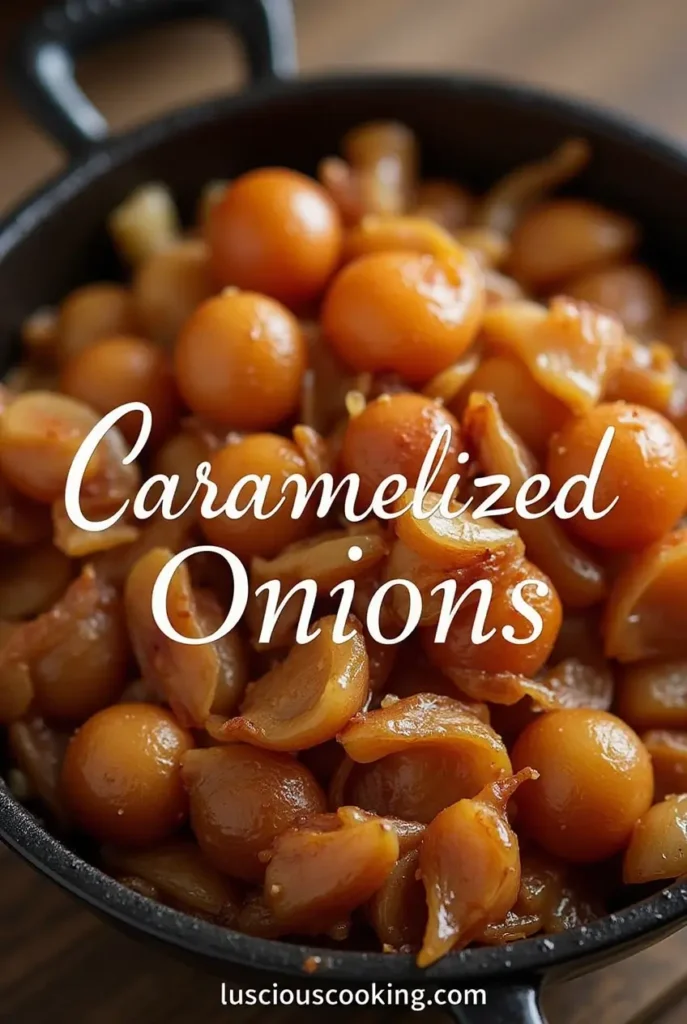
Choosing the Right Onions for Caramelization
Selecting the appropriate onion variety is crucial for achieving perfect caramelization. While all onions Can be caramelized, certain types yield better results due to their sugar content and moisture levels.
Best Varieties for Caramelization
| Onion Type | Characteristics | Ideal Uses |
|---|---|---|
| Yellow Onions | High sugar content, moderate moisture | Salads, garnishes, and visual appeal |
| Sweet Onions (Vidalia, Walla Walla) | Naturally higher sugar levels | Standalone dishes, gourmet applications |
| Red Onions | Vibrant color, slightly lower sugar content | Salads, garnishes, visual appeal |
| White Onions | Crisp texture, balanced flavor | Mexican cuisine, salsas, stir-fries |
Buying Tips for Fresh Onions
When selecting onions at the market, keep these quality indicators in mind:
- Look for firm bulbs with dry, papery skin
- Avoid onions with soft spots, mold, or sprouting
- Check for uniform size to ensure even cooking
- Smell for fresh, earthy aroma (avoid musty odors)
- Choose onions that feel heavy for their size
Substitutions and Alternations
If you can’t find your preferred onion variety, consider these alternatives:
| Desired Onion | Suitable Substitute | Notes |
|---|---|---|
| Yellow Onion | Shallots | Use 1.5 times the amount for similar flavor |
| Sweet Onion | Leeks | Adds creaminess but requires longer cooking |
| Red Onion | Purple Shallots | Maintains color but may be stronger in flavor |
Professional chefs often recommend:
- Using a mix of yellow and sweet onions for complex flavor profiles
- Storing onions in a cool, dark place with good air circulation
- Pre-peeling and slicing onions up to two days ahead for faster preparation
Remember that while all onions can be caramelized, starting with the right variety ensures optimal results and reduces cooking time. For beginners, yellow onions remain the most reliable choice due to their balanced flavor and consistent performance.
Caramelized Onions Ingredients & Preparation Essentials
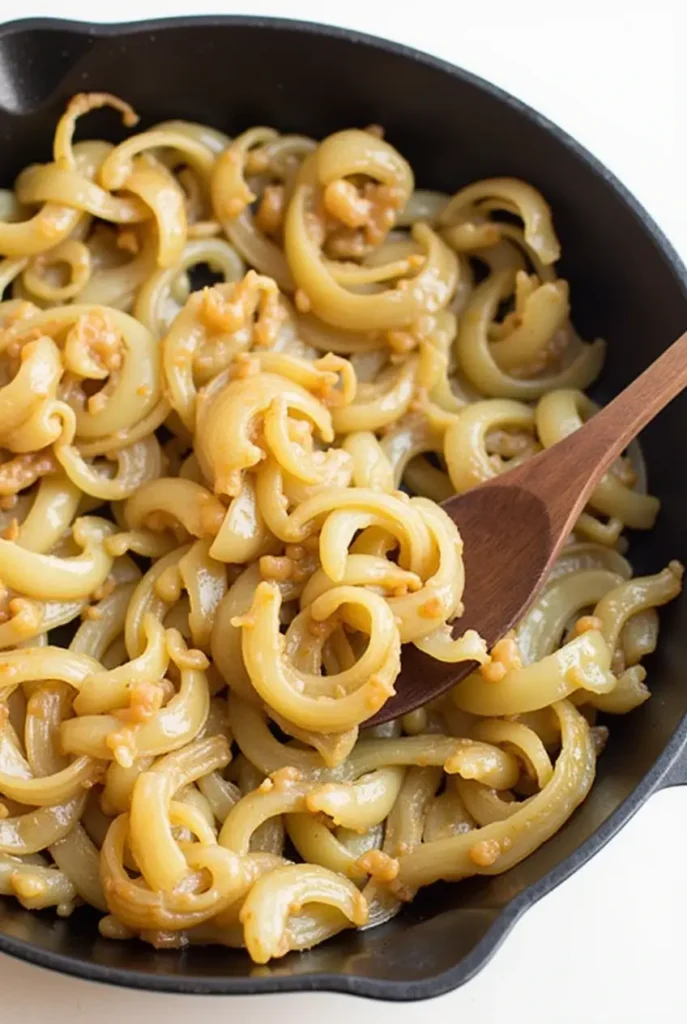
Mastering the preparation phase is crucial for achieving perfect caramelized onions. Let’s break down the essential components and preparation techniques that will set you up for success.
Essential Ingredients Checklist
| Ingredient | Quantity | Purpose |
|---|---|---|
| Onions | 4 medium | Base ingredient |
| Butter | 2 tablespoons | Adds richness and depth |
| Olive Oil | 1 tablespoon | Prevents burning and adds stability |
| Salt | 1 teaspoon | Draws out moisture and enhances flavor |
| Sugar (optional) | 1 teaspoon | Accelerates caramelization process |
| Black Pepper | To taste | Balances sweetness with subtle heat |
Preparation Techniques
Cutting Methods
- Uniform Slicing: Use a mandoline or sharp chef’s knife to slice onions evenly (1/8 inch thick).
- Direction Matters: Cut against the grain for faster, more even cooking.
- Batch Processing: Prepare onions in manageable batches to prevent overcrowding.
Initial Treatment
- Dry Surface Preparation: Pat sliced onions dry with paper towels to remove excess moisture.
- Seasoning Timing: Add salt at the beginning to draw out moisture gradually.
- Fat Distribution: Combine butter and olive oil in the pan before adding onions for even coating.
Equipment Recommendations
| Tool | Importance | Alternative |
|---|---|---|
| Heavy-bottomed Pan | Prevents burning | Cast-iron skillet |
| Wooden Spoon | Gentle stirring | Silicone spatula |
| Splatter Guard | Controls mess | Lid slightly ajar |
Temperature Control for Caramelized Onions
Understanding heat management is crucial:
- Start with medium-low heat (275°F-300°F)
- Adjust the heat as moisture evaporates
- Maintain a consistent temperature throughout the cooking process
Pro Tip: Place a metal ring or heat diffuser under your pan to distribute heat evenly and prevent hot spots.
By meticulously preparing your ingredients and equipment, you create the foundation for successful caramelization. Remember that proper preparation accounts for 80% of your final results, making these initial steps vital for achieving restaurant-quality caramelized onions.
Caramelized Onions Step-by-Step Cooking Instructions
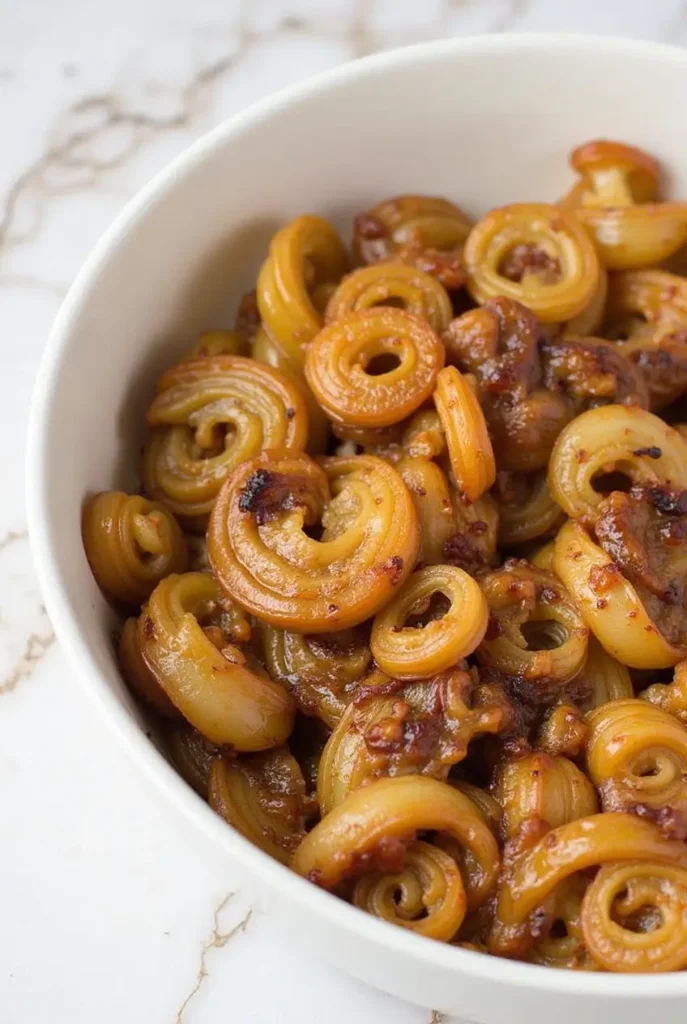
Now that we’ve covered the preparation essentials, let’s walk through the precise cooking process for perfect caramelized onions. Follow these detailed steps carefully to achieve restaurant-quality results every time.
Pre-Cooking Prep
- Pan Selection: Choose a wide, heavy-bottomed pan (at least 12 inches in diameter). The increased surface area allows moisture to evaporate efficiently.
- Temperature Setup: Preheat your pan over medium-low heat (approximately 275°F). Use an infrared thermometer to verify temperature accuracy.
- Initial Fat Addition: Melt 1 tablespoon of butter with 1 tablespoon of olive oil in the pan. This combination prevents burning while adding rich flavor.
Core Cooking Method
- Adding Onions: Carefully add your prepared onions to the pan, spreading them evenly across the surface.
- Initial Stirring: Stir gently every 5 minutes during the first 15 minutes to prevent sticking and ensure even cooking.
- Moisture Management: After 15 minutes, reduce stirring frequency to every 10 minutes. Allow natural sugars to concentrate without excessive disturbance.
Monitoring Progress
| Time Elapsed | Visual Cues | Action Required |
|---|---|---|
| 0-15 minutes | Pale yellow, releasing moisture | Frequent gentle stirring |
| 15-30 minutes | Light golden, reduced volume | Reduced stirring frequency |
| 30-45 minutes | Deep amber, sticky texture | Minimal stirring, watch closely |
| 45-60 minutes | Rich brown, jam-like consistency | Final seasoning adjustments |
Doneness Assessment
- Color Test: Look for deep amber-brown color throughout the batch.
- Texture Check: Onions should have a soft, jam-like consistency without any crunch.
- Flavor Sample: Taste for balanced sweetness with subtle bitterness.
Finishing Touches for perfect Caramelized Onions
- Final Seasoning: Add remaining butter and adjust salt to taste.
- Deglazing Option: Deglaze the pan with 1 tablespoon of water or stock to incorporate flavorful fond.
- Cooling Process: Remove from heat and allow to cool slightly before serving or storing.
Pro Tip: If onions begin to stick excessively, add 1 teaspoon of water at a time rather than increasing the heat. This maintains proper caramelization without burning.
By following these precise steps and monitoring points, you’ll achieve consistently perfect caramelized onions that rival those found in professional kitchens. Remember that patience and attention to detail are key to mastering this technique.
Pro Tips for Perfect Caramelized Onions
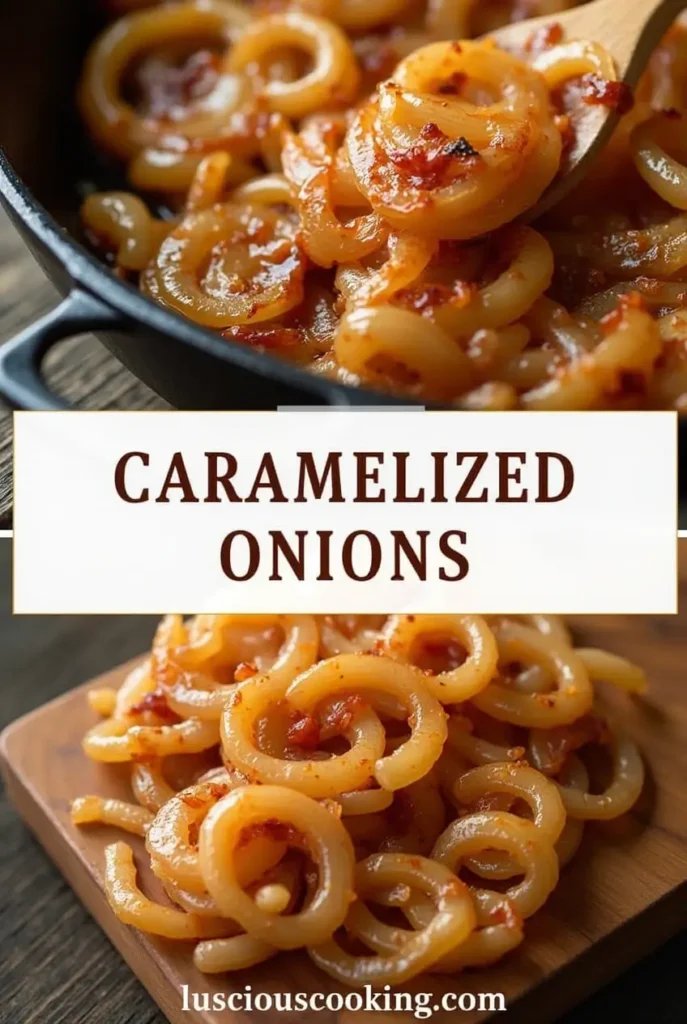
Elevate your caramelized onion game with these expert strategies and recommendations. Professional chefs swear by these techniques to achieve consistently excellent results while avoiding common pitfalls.
Caramelized Onions Advanced Cooking Techniques
| Common Issue | Solution | Implementation |
|---|---|---|
| Burning Edges | Use indirect heat | Place a metal ring under your pan |
| Uneven Browning | Pat the onions dry mid-process | Quarter-turn every 15 minutes |
| Excess Moisture | Pat onions dry mid-process | Use paper towels after 20 minutes |
Caramelized Onions: Essential Tools for Success
Invest in these professional-grade tools to streamline your caramelization process:
- Heavy-Duty Tongs: Allows gentle stirring without crushing delicate onion layers.
- Silicone-Tipped Spatula: Prevents scratching while effectively scraping fond.
- Infrared Thermometer: Ensures precise temperature control throughout cooking.
- Splatter Screen: Contains mess while allowing steam to escape.
Storage and Reheating Guidelines
| Storage Method | Shelf Life | Reheating Tips |
|---|---|---|
| Refrigerator | 7-10 days | Reheat gently in pan with splash of water |
| Freezer | 3 months | Thaw overnight, reheat slowly to preserve texture |
| Vacuum-Sealed | 6 months | Microwave-safe bags for easy reheating |
Troubleshooting Chart
| Problem | Cause | Fix |
|---|---|---|
| Bitter Taste | Overcooking | Reduce heat, monitor closely |
| Watery Texture | Insufficient cooking | Extend cooking time, increase evaporation |
| Pale Color | Low sugar content | Add pinch of sugar, use sweeter onion varieties |
Professional Insight: Always start with room-temperature onions and fat to ensure even heat distribution and optimal caramelization.
These pro tips and tools will help you refine your technique, troubleshoot common issues, and maintain the quality of your caramelized onions through storage and reheating. Implement these strategies to achieve restaurant-worthy results every time.
Flavor Variations and Global Inspirations
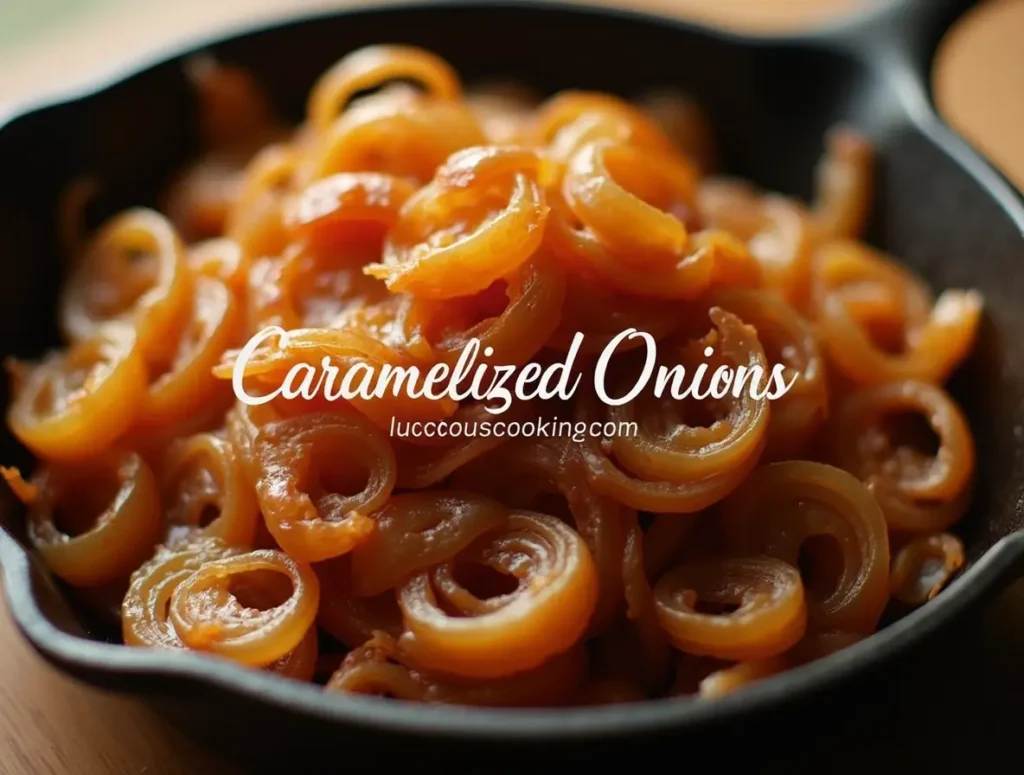
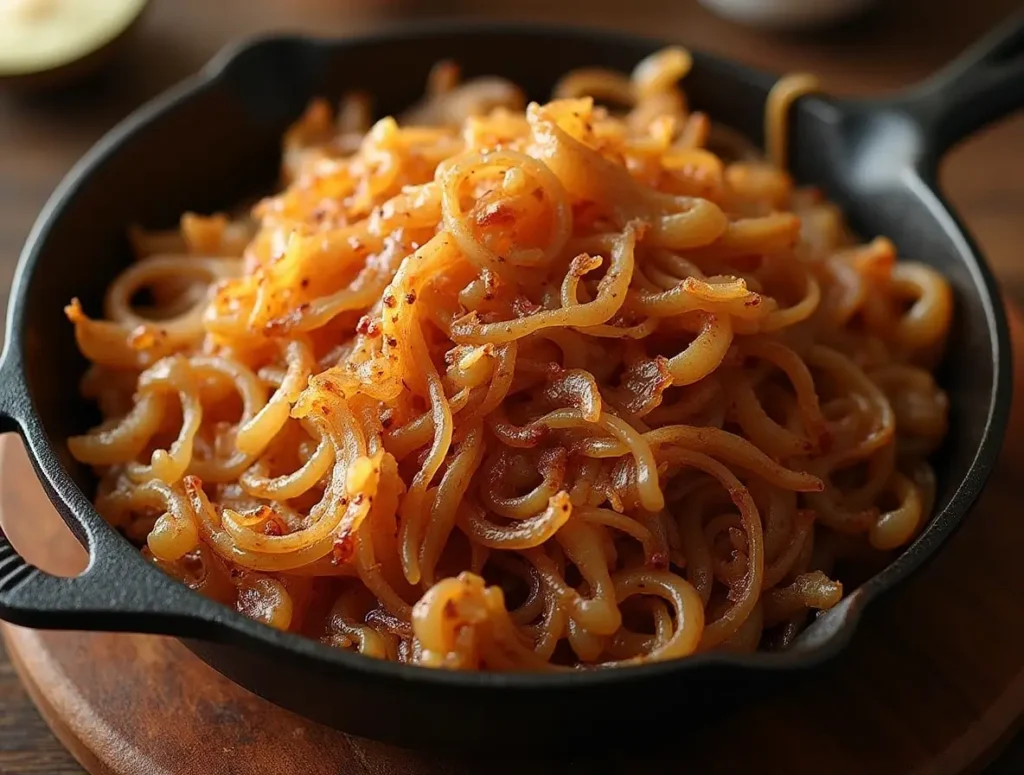
Expand your caramelized onion repertoire with these creative variations that cater to diverse dietary needs and international cuisines. These adaptations demonstrate the remarkable versatility of caramelized onions while maintaining their signature sweetness and depth.
Dietary Adaptations
| Diet Type | Modification | Serving Suggestions |
|---|---|---|
| Keto/Paleo | Replace sugar with monk fruit extract | Serve with grass-fed beef or cauliflower mash |
| Vegan | Use coconut oil instead of butter | Pair with roasted vegetables or plant-based proteins |
| Low-Sodium | Omit added salt, use herbs for flavor | Combine with quinoa or wild rice dishes |
International Flavor Profiles
| Cuisine | Additional Ingredients | Classic Pairings |
|---|---|---|
| French | Thyme, bay leaf, white wine | Beef bourguignon, tartiflette |
| Indian | Curry leaves, mustard seeds, turmeric | Dal makhani, biryani dishes |
| Middle Eastern | Sumac, pomegranate molasses, za’atar | Shawarma wraps, fattoush salad |
Spice Variations
- Spicy Twist: Add chipotle powder or red pepper flakes during the last 10 minutes of cooking.
- Herbaceous Blend: Incorporate fresh rosemary and sage in the final stages.
- Citrus Infusion: Finish with orange zest and a splash of balsamic vinegar.
Fusion Creations
| Fusion Style | Key Ingredients | Recommended Uses |
|---|---|---|
| Tex-Mex | Smoked paprika, cumin, lime juice | Tacos, nachos, fajitas |
| Asian Fusion | Soy sauce, ginger, sesame oil | Ramen bowls, stir-fries |
| Mediterranean | Harissa paste, preserved lemon | Flatbreads, mezze platters |
Pro Tip: When experimenting with new flavor combinations, start with small amounts and adjust gradually to maintain the delicate balance of caramelized onion sweetness.
These variations showcase how caramelized onions can be adapted to suit different dietary preferences and cultural influences while still delivering their characteristic depth of flavor. Try combining elements from multiple variations to create unique fusion flavors that reflect your taste preferences.
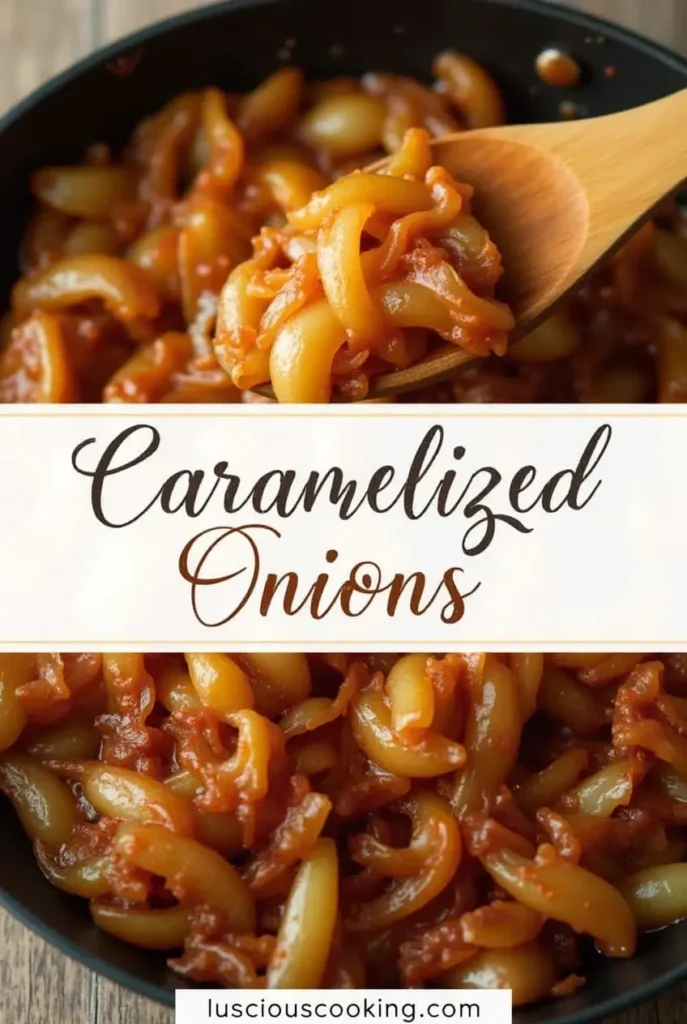
Caramelized Onions: Serving Suggestions
Maximize the impact of your perfectly caramelized onions by pairing them with complementary sides and beverages. These thoughtful combinations elevate your dishes from simple accompaniments to show-stopping culinary experiences.
Classic Side Dish Pairings
| Main Course | Recommended Side | Serving Style |
|---|---|---|
| Grilled Steak | Creamy Polenta | Top steak directly |
| Roast Chicken | Mashed Potatoes | Mix into potatoes |
| Pork Chops | Braised Greens | A layer between the meat and the greens |
Beverage Pairing Guide
| Onion Preparation | Wine Pairing | Beer Recommendation |
|---|---|---|
| Sweet Caramelized | Riesling | Belgian Dubbel |
| Spicy Variation | Gewürztraminer | IPA |
| Herb-Infused | Chardonnay | Saison |
Cheese and Charcuterie Combinations
| Cheese Type | Cured Meat | Presentation Tip |
|---|---|---|
| Gruyère | Prosciutto | Create mini tartlets |
| Blue Cheese | Salami | Stuff mushroom caps |
| Brie | Coppa | Assemble crostini |
Sandwich and Burger Enhancements
- Classic Burger: Spread caramelized onions beneath cheese for perfect melting
- Grilled Cheese: Layer between slices of sourdough with fontina
- French Dip: Serve alongside au jus for dipping
Pro Tip: For optimal presentation, reserve some whole caramelized onion rings to garnish dishes, while using the remainder as a spread or topping.
These serving suggestions demonstrate the versatility of caramelized onions across various culinary applications. Whether you’re crafting elegant Dinner party menus or casual weeknight meals, these pairings ensure your caramelized onions shine in every possible context.
Frequently Asked Questions About Caramelized Onions
Q: My onions always burn before they caramelize. What am I doing wrong? A: This typically occurs due to excessive heat. Maintain a consistent medium-low temperature (275°F-300°F) and stir regularly during the initial stages. Consider using a heat diffuser if your stove runs hot.
Q: How can I speed up the caramelization process? A: While patience yields the best results, you can add 1 teaspoon of sugar per pound of onions to accelerate browning. However, avoid increasing heat as this leads to burning rather than proper caramelization.
Q: Can I fix onions that have started to burn? A: Yes, transfer the onions immediately to a clean pan, leaving behind any burnt bits. Deglaze the original pan with water, strain, and reincorporate the liquid for additional flavor.
Q: How long can I store caramelized onions? A: Properly stored in an airtight container:
- Refrigerator: Up to 10 days
- Freezer: Up to 3 months
- Vacuum-sealed: Up to 6 months
Q: Are caramelized onions safe for pregnant women? A: Yes, when cooked to proper doneness and stored correctly. Ensure onions reach at least 165°F during cooking and consume within safe storage periods.
Q: What’s the difference between sautéed and caramelized onions? A: Sautéed onions cook quickly over higher heat, resulting in a softened texture but minimal browning. Caramelized onions undergo a slower cooking process (45-60 minutes) that develops deep brown color and complex sweetness through sugar breakdown.
Q: Can I caramelize frozen onions? A: While possible, results vary. Frozen onions release more moisture, extending cooking time. For best results, thaw completely, pat dry thoroughly, and increase initial cooking time by 15-20 minutes.
Pro Tip: Keep a log of your caramelization experiments, noting temperature, timing, and results. This helps identify patterns and refine your technique over time.
Understanding these common questions and their solutions empowers you to approach caramelized onion preparation with greater confidence and expertise.

